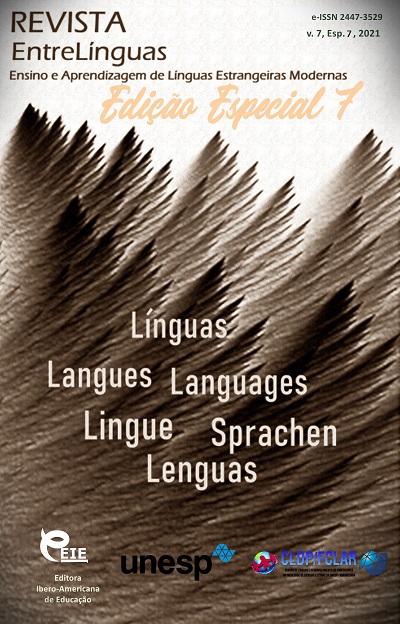Evaluation of the global companies’ language strategies to prosper
DOI:
https://doi.org/10.29051/el.v7iesp.7.16273Keywords:
International companies, Communication strategies, Translation, Language strategyAbstract
In today’s fast-paced world, international companies encounter an intriguing paradox: Technology permits them to attain new audiences worldwide and makes them improve their communication strategies to adjust to those culturally and linguistically diverse areas favorably. The present paper attempts to present an algorithm for applying analytical tools necessary for assessing and managing the language strategies of global companies. To meet that aim, collection and processing, such general scientific methods of knowledge are taken into account. In the process of conducting analytical procedures, a system of indicators was adapted: liquidity, language abilities, communication skills, business activity, financial soundness, and efficiency. Besides translation, localization performs an essential role in international companies’ progress. Big companies are developing their language strategy exceeding simple translation from one language to another. They are somewhat adjusting their overall business and content policy to meet various cultural and linguistic audiences.
Downloads
References
Grankin V.F., Marchenkova I.N., Udovikova A.A. Innovative approach to the formation of financial characteristics of the reference dynamics of enterprise development // Bulletin of Kursk State Agricultural Academy. - 2017. - № 4.- P.66-72. (In Russian)
Grigoryeva, T. I. Financial analysis for managers. Assessment, forecast. Textbook / T.I. Grigorieva. - M.: Yurait, 2020. - 496 p. (In Russian).
Zharylgasova B.T. Analysis of Financial Statements / B.T. Zharylgasova, A.E. Suglobov, V.Y. Savin. - Moscow: Titan Effect, 2020. - 320 p. (In Russian).
Tonkikh A.S. Formation of the reference dynamics of development as a basis for identifying weaknesses in the financial performance of the enterprise // Economic Analysis: Theory and Practice.- 2005.- № 21. - P.46-54. (In Russian)
Shadrina G. V. Economic analysis: textbook and practical work for universities / G. V. Shadrina. - 2nd edition revised and supplemented. - Moscow : Yurite Publishing House, 2020. - 431 p. - Text: electronic // EBS Yurait [website]. - URL: https://urait.ru/bcode/450141. (In Russian)
Sheremet A.D., Kozeltseva E.A. Financial analysis: tutorial. - Moscow: Faculty of Economics, Lomonosov Moscow State University, 2020. - 200 p. (In Russian)
Adizes I. Organizational passages: Diagnosing and treating life cycle problems in organization // Organizational Dynamics, 1979, vol. 9, pp. 3-25
Bragg S. M. Financial analysis: a controller’s guide, Wiley USA, 2012.- pp . 416.
Brauer M. F. The effects of short – term and long term oriented managerial behaviour on medium – term financial performance: longitudinal evidence from Europe, Journal of Business Economics and Management, 14 (2), 2013.- pp. 386– 402.
Greiner L. Evolution and revolution as organizations grow // Harvard Business Review, 1972, vol. 50, No.. 4.
Ohlson J.A. Financial Ratios and the Probabilistic Prediction of Bankruptcy, Journal of Accounting Research, 1980.- 18(1).- pp. 56-59.
Marchenkova I. N., Udovikova А.А., Lyakhovа N.I., Gordeeva N.O. Assessment of the impact of the state cadastre of real estate on a budget income // Humanities & Social Sciences Reviews eISSN: 2395-6518, Vol 7, No 5, 2019.- pp. 960-964 https://doi.org/10.18510/hssr.2019.75125.
Methodological recommendations on the analysis of financial and economic activity of organizations [Electronic resource]: approved by the Goskomstat of Russia 28.11.2002 // Reference legal system "Consultant Plus". Legislation". Information bank "Version Prof" (In Russian). 14.
Federal State Statistics Service [Electronic resource]. // http: www.gks.ru
Downloads
Published
How to Cite
Issue
Section
License

This work is licensed under a Creative Commons Attribution-NonCommercial-ShareAlike 4.0 International License.
Os manuscritos aceitos e publicados são de propriedade da Revista EntreLínguas. Os artigos publicados e as referências citadas na Revista EntreLínguas são de inteira responsabilidade de seus autores.
Transferência de direitos autorais – autorização para publicação
Caso o artigo submetido seja aprovado para publicação, já fica acordado que o(s) autor(es) autoriza(m) a UNESP a reproduzi-lo e publicá-lo na EntreLínguas, entendendo-se os termos “reprodução” e “publicação” conforme definição respectivamente dos incisos VI e I do artigo 5° da Lei 9610/98. O artigo poderá ser acessado pela rede mundial de computadores (Internet), sendo permitidas, a título gratuito, a consulta e a reprodução de exemplar do artigo para uso próprio de quem a consulta, desde que haja a citação ao texto consultado. Essa autorização de publicação 328 EntreLínguas, Araraquara, v. 1, n .2, p. 323-328, jul./dez. 2015 não tem limitação de tempo, ficando a UNESP responsável pela manutenção da identificação do(s) autor(es) do artigo. Os artigos publicados e as referências citadas na Revista EntreLínguas são de inteira responsabilidade de seus autores.











